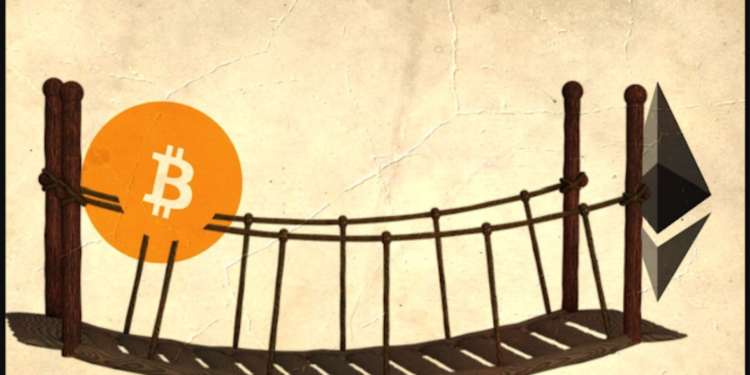As the crypto industry matures, one persistent challenge remains – the lack of interoperability between different blockchains. There are now thousands of cryptocurrencies and blockchain platforms, but most operate in silos, unable to communicate with one another.

This fragmentation limits adoption and real-world usage, as assets on one chain remain isolated from the vibrant ecosystem on another. Enter blockchain bridges – specialized infrastructure designed to transfer data and assets between otherwise incompatible networks.
Bridges effectively create highways between cryptoverses, allowing users to access opportunities across chains while retaining security guarantees. As blockchain bridges improve and adoption accelerates, they promise to play a pivotal role in connecting crypto’s disjointed worlds into an integrated system.
The Need For Connectivity
Many investors hold portfolios spanning multiple chains like Ethereum, Solana, Avalanche, and others. Yet moving assets between these networks can be prohibitively complex for average users, often requiringcustodial workarounds. Bridges simplify the process to a few clicks – vastly improving interoperability.
Bridges also allow users to access advantages unique to each chain. For example, one could leverage fast and cheap transactions on Avalanche to trade while benefiting from Ethereum’s unparalleled DeFi ecosystem for yield. Projects can complement strengths instead of directly competing.
Overall, bridges mesh complementary platforms into an interconnected web of crypto networks. This builds redundancy against vulnerabilities on any single chain and unlocks combined potential far beyond what isolated platforms can provide.
Just as intranets evolved into the interoperable internet we know today, bridges promise to link blockchains into a unified environment.
How Blockchain Bridges Work
Bridges enable communication using a combination of smart contracts, blockchain validators, and crypto assets that can be recognized across protocols. Here are some key mechanisms under the hood:
Smart Contracts: These programs handle logic for bridged token issuance, validation, and relaying between chains.
Validators: Special validator nodes monitor events across networks to enable asset transfers according to bridge contracts.
Bridged Assets: Crypto tokens or versions of tokens that bridge protocols issue to represent assets held on external chains.
When a user sends assets via a bridge, chain-specific validators facilitated by smart contracts lock up the original coins on the source chain while minting bridged representations on the destination network.
Bridged assets retain full 1:1 backing – they can be redeemed anytime via the blockchain bridge to unlock original assets on the other side.
Prominent Blockchain Bridge Projects
Several leading bridge protocols are driving crypto’s developing interconnectedness. Here are some noteworthy projects in the space:
Wormhole: Created by Jump Trading and Certus One, Wormhole bridges tokens between Solana, Ethereum, Terra, and Oasis. It continues to push functionality and efficiency for Solana’s booming DeFi Way ecosystem.
Axelar: This transition layer facilitates cross-chain communication for over 20 chains and counting. Axelar focuses on leveraging messaging to enable use cases like decentralized finance across networks.
Celer: The cBridge platform from Celer builds portable applications and structured interoperability focused primarily between Ethereum, Polkadot, Binance Chain, and layer 2 solutions.
Quantum tunnels are another emerging approach that uses teleportation methods to achieve near-instant, low-cost bridging. Leading projects here include Thorchain, Nomad, and Hop Protocol – all gearing up for mainnet deployment to further unify liquidity across chains.
Real-World Use Cases
As bridges enhance chain interlinking, use cases are expanding across domains like decentralized finance (DeFi), non-fungible tokens (NFTs), infrastructure, and more:
DeFi Way: Cross-chain lending/borrowing, trading, yield aggregation Infrastructure: Scalable message passing, asset teleportation NFTs: Metaverse/gaming item portability, cross-platform transfers Plus countless moreLocale-specific solutions for payments, supply chain tracking, identity, etc.

For example, Axelar has enabled decentralized exchanges like Gravity DEX to launch pools simultaneously harnessing liquidity from multiple chains – combining the array of altcoin pairs on Ethereum with Solana’s penny transaction costs.
Similarly, Wormhole permits projects like Mars Protocol to build collateralized lending markets using wrapped BTC on Solana. This brings Bitcoin’s $400 billion market cap and unparalleled brand value into Solana’s thriving DeFi landscape.
Use cases like these were previously impossible or relied on centralized custodians before purpose-built blockchain bridges unlocked uncompromised composability between chains.
The Path To A Connected Crypto Economy
Blockchain bridges are rapidly evolving – smarter protocols, an expanding roster of integrated chains, and growing adoption in tandem with DeFi and Web3 at large.
While technical challenges around centralization and security need addressing, bridges appear poised to enable a truly unified environment across the thousands of blockchains constituting the crypto economy.
Seamless interoperability unlocks network effects across chains that can radically boost utility. No longer competing isolated platforms, blockchains can focus on complementing each other’s strengths – interlinked like intrabranches of the same tree.
Accordingly, bridges cement an integral piece of infrastructure for crypto’s broader penetration into mainstream finance – one that promises to propel this disjointed industry toward becoming a connected economic web fueling the world’s value transactions.
Just as packet switching unified fragmented networks into the eventual Internet, blockchain bridges are set to link headless blockchains into a cohesive system – one flexibly interoperable metaverse comprising the best of all crypto worlds.







